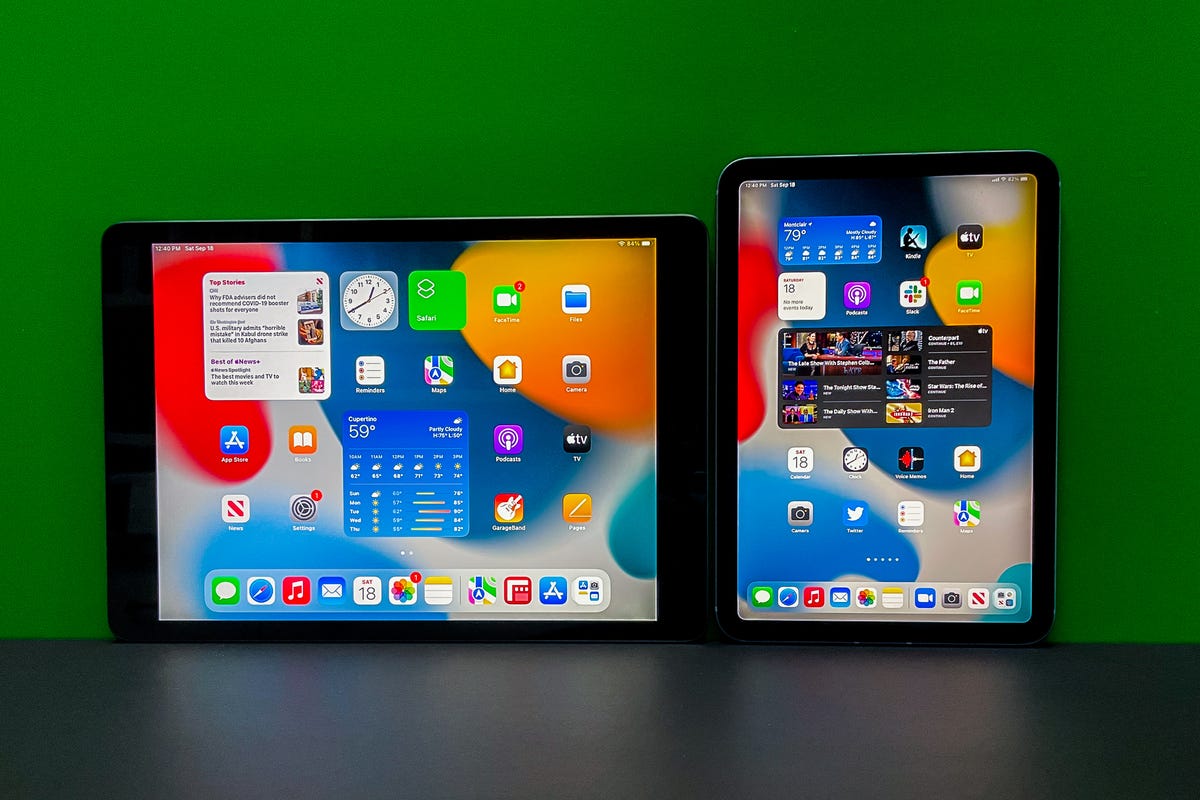
The ninth-gen iPad (left) and iPad Mini 2021 (right) are now available. They're Apple's more affordable iPads. Which is for you? I reviewed both, so here's a guided tour.
The 10.2-inch iPad is less expensive, and has a larger display. But it has an older design with an improved processor (A13), while the 8.3-inch Mini has an even faster processor (A15) a bigger display, a more iPad Pro or iPad Air-like design, and USB-C.
The iPad connects with keyboard cases and uses a first-gen Pencil. The Mini doesn't have its own special keyboard case yet, but Pencil 2 snaps nicely onto its side.
The Mini I reviewed is purple, but it's subtly purple. It comes in several colors. The new iPad just comes in space gray and silver.
The rear cameras, compared: The Mini's is better and has a flash.
I don't use rear cameras on iPads much. Both iPads have 12MP wide-angle front cameras with Center Stage, which zooms in on and follows your face in video chats. That's a big plus.
The Mini (top) has USB-C, a standard charge port that's helpful. The iPad still has Lightning, like always.
Comparing screen sizes while browsing. The Mini can feel small.
Games look good on the Mini, but the regular iPad feels more expansive.
Videos? Same thing, but the longer Mini screen and aspect ratio means less letterboxing.
I use the larger iPad like a laptop, but the Mini seems more suited to a reading, sketching and viewing role.
Bright daylight isn't your friend with these displays, alas.
The iPad and Mini next to the iPhone 12 Pro. There's a big screen size spectrum.
Mini (left), iPad 9th gen (middle), and last year's iPad Air (right), which shares a lot of the new Mini's looks.
Another group photo.
You can see the screen size differences here between the Mini (left), Air (middle), and 12.9-inch iPad Pro (right).
Rear camera comparison on the regular iPad (left), Mini (middle, which has a flash now) and iPad Pro (which has two cameras for extra wide angle, plus lidar).
The iPad Air (right) from last year has a larger screen, but costs more and has an older A14 processor, and lacks the Center Stage camera for zooming in. But it also supports keyboard cases like the Magic Keyboard, which the Mini doesn't. On sale, it could be preferred for some.
The 12.9-inch Pro vs the Mini. The Pro nearly has double the Mini's screen size.
Now, lots of iPad Mini photos. Sit back and browse.
Comparing the Mini to other portable devices it reminds me of: the Nintendo Switch, a Kindle Oasis, the Microsoft Surface Duo, a Samsung Galaxy S21.
Same shot with an iPhone 12 Pro.
More iPad Mini photos...
There's 5G, but the Mini doesn't support mmWave, just Sub-6. That could mean slower speeds. And you have to pay $150 for the cellular modem, and data plans.
Popping the SIM card in...
Center Stage can be turned on and off in Control Center while you're in an app that uses Center Stage. FYI.
The Mini's longer screen means some apps have pillarboxing or black bars on the sides, just so you know.
A few comparison photos follow, showing the iPad Mini 2019 version with the 2021 version. You can see how the screen size gain does and doesn't matter. depending on the apps you run.
Microsoft's folding Surface Duo phone is nearly the same size. It makes me think...could the Mini eventually become Apple's first folding device?
Just a thought.
Switch vs Mini: with Apple Arcade, the iPad is a great game device. But it also costs more.
The ninth-gen iPad photos follow: it all looks the same as last year. Which is good because older cases still fit.
But that Pencil charging situation...
Lightning still here.
Pencil and the keyboard case cost extra.
There's still a headphone jack! Thank God.
Typing outdoors. The basic iPad can still be a fair laptop stand-in in a pinch.
Although, I miss the Magic Keyboard. Logitech makes an even better keyboard case for typing, FYI.



